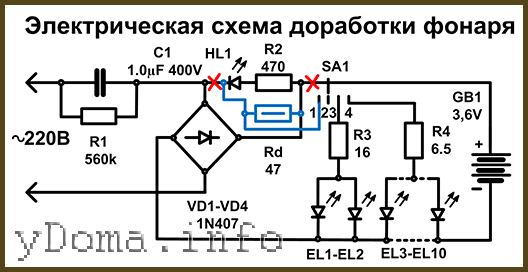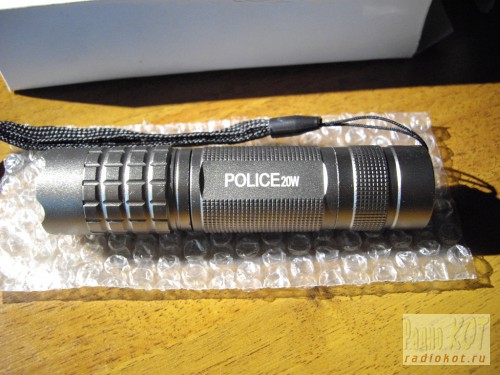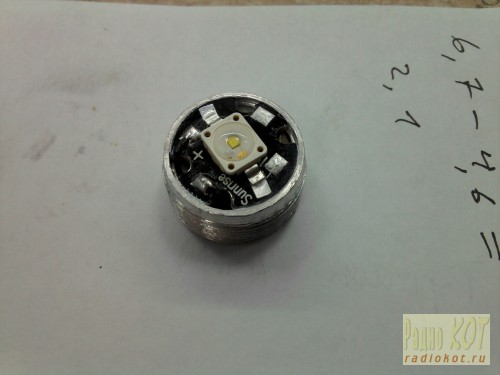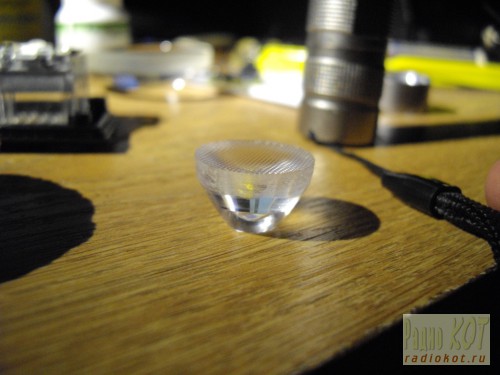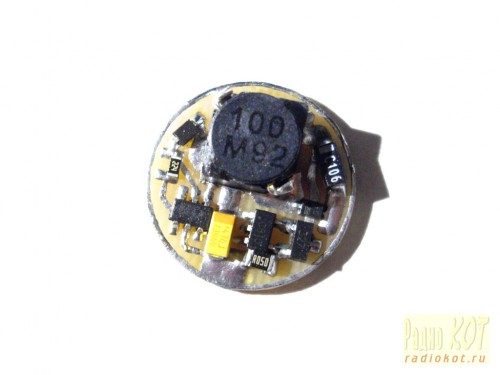In detail: DIY flashlights repair diagrams from a real master for the site my.housecope.com.
Global refinement of the LED flashlight
Chinese-made LED flashlights, which ignite our entire market - it seemed that it could be simpler (as experience shows - for China it is too simple), there seems to be a large selection, but in each flashlight you may not like something, but if you go deeper into internals, and circuitry - sometimes you wonder how it works.
I set myself the task - "Find a suitable donor, and collect a lantern suitable for survival, with which you can go anywhere." After a long search, a donor was found:
Upon purchase, the flashlight was disassembled and the insides analyzed. Inside there was a single-watt LED with a reflector giving a very large side illumination and a very narrow beam of light. The driver (if you can call it that) consisted of a small number of parts - a ME2108A microcircuit, an inductor, a capacitor, and a diode. Everything seems to be fine, but the choke with the microcircuit in this circuit was very hot, the circuit consumed about 0.5A from the finger battery, and the LED gave a relatively weak luminous flux. As it turned out later, this converter gave no load to the output of 4.5V, and the LED was designed for 3.6V, due to the low saturation current of the choke, the output voltage dropped to the required one and the circuit “worked”.
Since my task was to make an effective light source, and not to use a Chinese driver whose efficiency is “lower than that of a steam locomotive,” I decided to modify it by changing the LED to OSRAM LUW W5AM-LXLY-6P7R-Z with an OSS-M collimator at an angle of 30 ° (we could have supplied everyone's favorite Cree, but we have problems with them, such as the lack of small substrates and optics), and supply a driver based on a specialized microcircuit ZXSC310.
The OSRAM LED was chosen for a number of reasons: at a current of 350mA, the LED gives a luminous flux of up to 150 lumens, the maximum LED current is 1A, this LED is almost compatible with the standard one in terms of fit, it has the lowest price for its power.
Replacing the LED is done by heating the LED substrate from below. We unsolder the old LED and install it by centering the new one (fortunately, they are almost pin-compatible, but this does not interfere with replacement).
Next, we adjust the body of the flashlight to our optics (which needs to be adjusted to the flashlight)), bore the place for the collimator:
It is also necessary to remove the chamfer from the edge of the case to the thread, and reduce the height of the optics mounting nut (since our system is lower than the standard one).
As the experience of using various flashlights has shown - a narrow beam of bright light in most cases impairs visibility and gives low illumination, so my choice was a 30º LEDIL collimator with OSS-M marking, designed for OSRAM DRAGON LEDs.
Modifying the collimator (by default the collimator is square and in a housing for gluing to the LED substrate). We pull out the collimator from its body, cut off the ears and grind it down to the required diameter on a sharpener.
The last modification of the case - boring of the hole for the optics fastening nut (made at the factory on the machine), and sealing. The hole is bored literally 3mm to almost the collimator diameter. To seal, we glue a complete protective plexiglass onto the hot melt glue (for this it is convenient to heat the nut with a hairdryer and spread the hot melt glue on a hot surface), it is also necessary to seal all threaded connections, although there are rubber seals - they do not help because they do not get it, to solve this problems we wind the plumbing tape into the grooves for the seals, and install the complete sealing rings (it is advisable to lubricate them on top, for example, with petroleum jelly or ciatim).
So, everything seems to be clear with the case, now we are finally getting down to electronics.
| Video (click to play). |
The first version of the flashlight was with a widespread driver circuit on the ZXSC310 with a driver powered from the output (this circuit allows you to “squeeze out” all the power from the battery, and drains the voltage on the battery in one go to the smallest possible minimum).
But since I was infected with a terrible disease - “Lumen's” disease, and besides the fact that it is necessary to obtain greater brightness, we need the versatility of the lantern and a long operating time. For high brightness, ordinary finger-type batteries are not suitable, and I used a 700 mAh Li-Ion LIR14500 battery, which is the same size as a conventional finger-type battery. But that's not the problem - the battery voltage in a charged state is 4.2V, and the maximum LED voltage at a current of 300mA is 3.4V. The step-up driver is not suitable.
This is where I decided to use the basic Buck-Boost circuitry. In addition to the driver circuit, I decided to make two brightness modes, for this I used a miniature PIC10F220.
This driver circuit provides power to the LED with a current of up to 300mA when powered from a battery, and a current of about 100mA when powered from a battery. Since there is no LED current feedback in this circuit, the current decreases when powered from a finger-type battery, but the current instability when operating on battery power is almost invisible.
The second task was to develop a driver control system. This system should detect the voltage of the battery charge, and indicate it when the charge is low. It is also necessary to provide 2 brightness modes (to increase the duration of the glow).
This scheme provides:
-Switching modes with short-term power failure
-Two brightness modes
-Indication of battery discharge and shutdown of the driver at full discharge
-Ability to work from a finger-type battery
When using a battery, the control system does not work (the internal pull-up resistor of the driver microcircuit starts the driver), but as soon as the battery is installed, the supply voltage becomes sufficient to start the controller, and the flashlight turns on in the first "Economy" mode at 40% brightness. When the power button is pressed briefly, the power is turned off, and when the button is released, the second mode is activated - maximum brightness.
To indicate the battery discharge, I used an ADC and measuring the voltage of the internal reference source 0.6V (the ADC values are inversely proportional to the supply voltage, taking into account the drop across the diode). When the voltage drops to the minimum, the flashlight switches to about 10% brightness, and when the battery is completely discharged, the controller turns off the driver.
Most of the problems were when trying to switch modes, and resetting the mode after a while (so that the flashlight would turn on not from the last mode, but from the economy), there were attempts to power the controller from the capacitor for the time the power was interrupted by the button, but there were problems with waking up from hibernation mode, since I used the GP2 port as a voltage presence sensor on the driver, and there are no interrupts on this port pin, and I considered switching to another one unfavorable for in-circuit programming of the controller. After conducting experiments for a long time, I noticed that the controller retains the state of the registers even with a long power outage, and after checking the theory, I understood what the matter is - on the capacitor C1, when the power is turned off, a charge of about 0.7V remains (at this voltage, the driver stops working), and this voltage is quite enough so that the last values (namely the mode) are saved in the registers of the controller. To "reset" the last state (occurs approximately 5s after shutdown), I put resistor R1.
Jumper JP1 was inserted just in case to disable the discharge control.
The double-sided board turned out to be quite miniature, and is installed in place of the standard one. I made metalizing of holes by riveting copper wire:
Details: tantalum capacitors in case A, inductor Sumida CDRH6D38NP-100NC, resistors of size 0603, low-resistance current sensor resistors - size 0805 with resistance 0.05 Ohm (marked E05) installed 2 pieces in parallel to each other to obtain a resistance of 0.025 Ohm, Schottky diode - miniature with a low current drop of 2A, a transistor (Zetex) for the maximum possible current in this case (you can put ZXTN25012, ZXTN19020). Another LED and optical system can be used, the main thing is that the LED is designed for a current of more than 300mA to reduce heat generation.
Do not turn on the driver without load! When turned on without load, at best, there will be a breakdown of the capacitor C2, at worst - failure of the transistor, followed by special effects in the form of fireworks.
Reverse polarity of the driver power supply is not allowed! When the polarity is reversed, the capacitor C1 and the transistor explode!
As a result, we got a flashlight that looks almost indistinguishable from the original (except for the optics, which are already attracting attention), but with the parameters and angle of the luminous flux much better than those of the original:
The firmware of this device is written in environmentally friendly assembly language.
An electric flashlight refers, as it were, to an additional auxiliary tool for carrying out any work in the presence of poor lighting or no lighting at all. Each of us chooses the type of flashlight at our discretion:
- Head Torch;
- pocket flashlight;
- hand-held flashlight
etc.
The electrical diagram of a simple flashlight in Fig. 1 consists of:
- battery cells;
- light bulbs;
- key switch.
The scheme in its execution is simple and does not require explanations in this regard. The reasons for the malfunction of the flashlight with this scheme can be:
- oxidation of contact connections with batteries;
- oxidation of the contacts of the bulb holder;
- oxidation of the contacts of the bulb itself;
- malfunction of the light switch key;
- a malfunction of the light bulb itself, the light bulb has burned out;
- lack of contact connection with the wire;
- lack of battery power.
Other reasons for the malfunction may be any mechanical damage to the body of the flashlight.
headlamp with LED BL - 050 - 7C
The BL - 050 - 7C flashlight comes on sale with a built-in charger; when such a flashlight is connected to an external AC voltage source, the battery is recharged.
Rechargeable batteries, or rather electrochemical accumulators, - the principle of charging such cells is based on the use of reversible electrochemical systems. Substances formed during the discharge of the battery under the influence of an electric current are able to restore their original state. That is, we recharged the flashlight and can continue to use it. Such electrochemical batteries or individual cells can consist of a certain amount, depending on the voltage consumed:
- the number of bulbs;
- type of bulbs.
The number, the set of such individual elements of the flashlight, is a battery.
The electrical circuit of the flashlight in Fig. 2 can be considered both consisting of a simple incandescent light bulb and a certain number of LED bulbs. For any flashlight circuit, what exactly is important? - It is important that the energy consumed by the light bulbs in the electrical circuit - corresponds to the output voltage of the power source of the battery, consisting of individual cells.
Resistor R1 with a resistance of 510 kΩ and a rated power of 0.25 W in the electrical circuit is connected in parallel, due to this large resistance, the voltage in the further section of the electrical circuit is significantly lost, or rather, part of the electrical energy is converted into thermal energy.
With a resistor R2 with a resistance of 300 ohms and a nominal power of 1 W, current flows to the VD2 LED. This LED serves as an indicator light to indicate the connection of the flashlight charger to an external AC voltage source.
The current is supplied to the anode of the diode VD1 from the capacitor C1.The capacitor in the electrical circuit is a smoothing filter, part of the electrical energy is lost with a positive half-cycle of the sinusoidal voltage, since during this half-cycle the capacitor is charged.
With a negative half-cycle, the capacitor is discharged and the current flows to the anode of the cathode VD1. An external voltage drop for a given electrical circuit occurs when there are two resistors and a light bulb in the electrical circuit. Also, it can be taken into account that when the current passes from the anode to the cathode - in the VD1 diode - there is also its own potential barrier. That is, it is also common for a diode to undergo heating to some extent, at which an external voltage drop occurs.
On the GB1 battery, which consists of three cells, a current of two potentials + - is supplied from the charger when the flashlight is connected to an external source of alternating voltage. In the battery, the electrochemical composition of the battery is restored to its original state.
The following diagram in Fig. 3, which is found in LED flashlights, consists of the following electronic elements:
- two resistors R1; R2;
- diode bridge consisting of four diodes;
- capacitor;
- diode;
- LED;
- key;
- batteries;
- light bulbs.
For a given circuit, the external voltage drop occurs due to all the constituent elements of the electronics - connected in this circuit. One diagonal of the diode bridge of the bridge circuit is connected to an external AC voltage source, the other diagonal of the diode bridge is connected to the load - consisting of a certain number of light-emitting diodes.
All detailed descriptions on replacing electronics elements when repairing a flashlight, as well as diagnosing these elements - you can find on this site, which contains similar topics in which repair of household appliances is seen.
For my work, I sometimes have to use a headlamp. Approximately six months after the purchase, the flashlight's rechargeable battery stopped charging after it was turned on for recharging via the power cord.
When establishing the cause of the headlamp breakdown, the repair was accompanied by photographs in order to present this topic in an illustrative example.
The cause of the malfunction was not clear at the beginning, since when the flashlight was switched on for recharging, the signal light came on and the flashlight itself, when the switch button was pressed, emitted a weak light. So what could be the reason for such a malfunction? Is the battery malfunctioning or some other reason?
It was necessary to open the body of the flashlight to inspect it. On the photographs of photo # 1, the screwdriver tip indicates the places where the body connection is fastened.


If the body of the flashlight cannot be opened, you need to carefully inspect to see if all the screws have been removed.
Photo # 2 shows a buck converter in both voltage and current.
You should not look for the cause of the malfunction in the circuit, since when connected to an external source, the signal light is on, photo # 2 is a red LED light. We check further connections.
In front of us in the photo # 3 shows the light switch of the LED flashlight. The contacts of the push-button post of the switch are a double light switch device, where for this example light up:
- six LED lamps,
- twelve LED bulbs
flashlight. Two contacts of the switch, as we can see, are short-circuited and a common wire is soldered to these contacts. Two wires are soldered to the next two contacts of the switch - separately, from which current flows to the lighting:

When switching, it is enough to check the contacts of the light switch with a probe as shown in photo # 4. We touch the common contact with two short-circuited contacts with a finger and alternately touch the other two contacts with a probe.
If the switch is in good working order, the LED lamp of the probe lights up photo # 4.The light switch is serviceable, we carry out further diagnostics.
The power cord can also be checked here with a photo # 5 probe. To do this, with your finger, you need to short-circuit the pins of the plug and alternately connect the probe to the first and second contacts of the cable connector. If the probe light comes on, there is no break in the power cord.

The power cord for recharging the battery is working properly, we carry out further diagnostics. You should also check the flashlight battery.
On the enlarged image of the storage battery, photo # 6, it can be seen that a constant voltage of 4 Volts is supplied to recharge it. The current strength of this voltage is - 0.9 ampere hour. We check the battery.
The multimeter in this example is set to a DC voltage measuring range of 2 to 20 Volts so that the measured voltage matches the specified range.
As we can see, the display of the device shows the constant voltage of the battery - 4.3 Volts. In fact, this indicator should take on a greater value - that is, there is insufficient voltage to power the LED lamps. LED lamps take into account the potential barrier for each such lamp, as we know from electrical engineering. Consequently, the battery does not receive the required voltage when recharging.
And here is the whole reason for the malfunction of photo # 8. This cause of the malfunction was not immediately established - in the break of the contact connection of the wire with the battery.
The wires in this scheme are unreliable for soldering, since the thin section of the wire does not allow them to be securely fastened at the soldering point.
But even this reason for the breakdown is removable, the wiring was replaced with a more reliable section and the LED flashlight is currently operational, it works flawlessly.
I consider the presented topic unfinished, they will be given in examples for you - repairs of other types of flashlights.
I would call it "Notes of a Shitty Electrician"! The author simply does not understand how the circuit works, its elements, he confuses the concepts. Using the example of the operation of the circuit in Fig. 2: R1 serves to discharge the capacitor C1 after disconnecting the flashlight from the mains for safety reasons. There is no "loss" of voltage "in the next section", let the Author connect a voltmeter and look at it to make sure of this. Resistor R2 serves as a current limiter. The VD2 LED serves not only as an indicator, but also supplies a positive potential to the + battery.
Capacitor C1 in this circuit is a quenching (and not a smoothing filter), and it is on it that the excess of the alternating voltage is extinguished.
About the potential barrier, too, heap it up - it's ridiculous to read. And the current "current of two potentials" ?! According to classical physics, current flows from positive to negative potential, and electrons move in reverse.
Did the author go to school?
And he has this everywhere. Sad. But someone takes his "revelations" at face value.
Hello povaga! I stopped charging the "Oblic 2077" flashlight on one LED. I can’t find any schemes, but it’s like in figure # 3. Difference: there is no capacitor C2, diode VD5, two resistors and a three-pin board are soldered to the SA1 switch. I measured the voltage after the bridge - 2 volts, the battery is 4 volts, how can it be charged? Please help with the operation diagram and electrical circuit. Thanks in advance, Regards, Doldin.
Hello Mikhail. That is, you measured the voltage at the output of the bridge circuit and your measuring device shows 2 volts - this is of course not enough to charge the battery. You need to check the resistors (for resistance) and the rest of the electronics that are located on the board, or you can give it to a workshop for checking - the circuit board and resistors, and get advice there (on replacing one or another part).
Victor.
Hello Victor! 2 volts after the bridge is when the load is completely disconnected, only the HL1 power-on indicator is connected. R1 = 560 KOhm, C1 = 105J, I checked the resistor - a whole one and a capacity of about 1 μF. How to increase the voltage after the bridge? Is there an electrical circuit "Oblique 2077", or tell me where to find it? Best regards, Doldin.
Hello, I have a flashlight "Era" well, and in the back on the glued tag it says FA 18 E, 182W - 1500614, the trouble is that when I inadvertently used the wrong charger instead of 6 volts, I did not charge, I disassembled on the diagram, the resistor is charred or otherwise the resistance, if you know then tell me what is the resistance on this flashlight
Hello Nikolay. If the resistor is charred, you need to check the rest of the electronics, such as the capacitor and diodes. There are two diodes, if I'm not mistaken. They could also lose their current conduction properties. You'd better take this small circuit for repair to fix the malfunction. If an electrical diagram with the nominal values of the electronic elements in the "Flashlight Operation Manual" was attached, then there would be no problems with the elimination of the malfunction.
Victor.
Hello, help me assemble the flashlight as in photo # 2, my brother repaired the button and tore off the wiring, we cannot assemble the circuit if you can give pictures in details of what to solder.
Hello Valery. As soon as I have free time, I will immediately answer your question (on the wire connections in the flashlight circuit). The topic will have a title: “How to assemble a flashlight. Photo and description ".
Victor.
Hello Valery. I told you the name of the topic, the topic will be published today.
Victor.
How to connect the wiring of an escaped flashlight as in photo # 2, you need a diagram, please.
Fired two resistances R1 R2 in the ERA FA35M lamp. Please tell me their data to replace.
Hello. I did not find data on the resistance of two resistors for your flashlight on the Internet. Try to go to a store that sells electronics parts to a sales consultant. I believe that the sales consultant will be able to select resistors by resistance.
Chinese headband oytventyre no screws please tell me how to open
Hello. I believe that it is impossible to open a flashlight with a stamping design.
Often there is no contact on the retractable plug for charging the flashlight. It is necessary to disassemble and bend the contacts.
Good afternoon. I inserted the wrong batteries, the flashlight blinked and that's it, is there a chance to repair it?
Hello. Of course, there is an opportunity to repair the flashlight. You need to ring the circuit and determine the cause of the malfunction.
How to fix your LED Chinese pocket flashlight yourself. DIY LED lights repair instructions with visual photos and videos
Today we are going to talk about how to fix an LED Chinese pocket flashlight by yourself. We will also consider instructions for repairing LED lights with our own hands with visual photos and videos
As you can see, the scheme is simple. The main elements: a current-limiting capacitor, a rectifier diode bridge on four diodes, a battery, a switch, super-bright LEDs, a flashlight battery charging indication LED.
Well, now, in order, about the purpose of all the elements in the flashlight.
Current limiting capacitor. It is designed to limit the charging current of the battery. Its capacity may vary for each type of flashlight. A non-polar mica capacitor is used. The operating voltage must be at least 250 volts. In the circuit, it must be shunted, as shown, with a resistor. It serves to discharge the capacitor after you unplug the flashlight from the charger. Otherwise, you could get an electric shock if you accidentally touch the 220 volt mains terminals of the flashlight.The resistance of this resistor must be at least 500 kOhm.
The rectifier bridge is assembled on silicon diodes with a reverse voltage of at least 300 volts.
A simple red or green LED is used to indicate that the flashlight battery is charging. It is connected in parallel with one of the rectifier bridge diodes. True, in the diagram, I forgot to indicate the resistor connected in series with this LED.
It makes no sense to talk about the rest of the elements, so everything should be clear anyway.
I would like to draw your attention to the main points of repairing an LED flashlight. Consider the main malfunctions and how to fix them.
1. The flashlight stopped shining. There are not so many options here. The reason may be the failure of super-bright LEDs. This can happen, for example, in the following case. You put the flashlight on charge and accidentally turned on the switch. In this case, a sharp current surge will occur and one or more diodes of the rectifier bridge may be punctured. And behind them, the capacitor may not be able to withstand it and will close. The battery voltage will rise sharply and the LEDs will fail. So, in any case, do not turn on the flashlight when charging, if you do not want to throw it away.
2. The flashlight does not turn on. Well, here you need to check the switch.
3. The flashlight runs out very quickly. If your flashlight is "experienced", then most likely the battery has worked out its service life. If you actively use the flashlight, then after one year of operation, the battery no longer holds.
Problem 1. LED flashlight does not turn on or flickers during operation
This is usually the reason for poor contact. The easiest treatment is to tighten all threads tightly.
If the flashlight doesn't work at all, start by checking the battery. Perhaps it is discharged or out of order.
Unscrew the back cover of the lamp and use a screwdriver to close the housing with the negative contact of the battery. If the flashlight lights up, then the problem is in the module with the button.
90% of the buttons of all LED lights are made according to the same scheme:
The button body is made of aluminum with a thread, a rubber cap is inserted there, then the button module itself and a pressure ring for contact with the body.
The problem is most often solved in a loosely clamped pressure ring.
To eliminate this malfunction, it is enough to find round-nose pliers with thin stings or thin scissors that need to be inserted into the holes, as in the photo, and turned clockwise.
If the ring moves, then the problem has been fixed. If the ring is in place, then the problem lies in the contact of the button module with the body. Unscrew the retaining ring counterclockwise and pull the button module outward.
Often poor contact occurs due to oxidation of the aluminum surface of the ring or rim on the printed circuit board. Indicated by arrows)
It is enough just to wipe these surfaces with alcohol and the functionality will be restored.
Button modules are different. Some in which the contact goes through the printed circuit board, others, in which the contact goes through the side lobes to the body of the lantern.
Just bend such a petal to the side so that the contact is tighter.
Alternatively, you can solder tin to make the surface thicker and press the contact better.
All LED lights are basically the same.
The plus goes through the positive terminal of the battery to the center of the LED module.
The minus goes through the body and closes with a button.
It will not be superfluous to check the tightness of the LED module inside the case. This is also a common problem with LED lights.
Using round nose pliers or pliers, rotate the module clockwise until it stops. Be careful, it is easy to damage the LED at this point.
These actions should be enough to restore the functionality of the LED flashlight.
It is worse when the flashlight works and the modes are switched, but the beam is very dim, or the flashlight does not work at all and there is a burning smell inside.
Problem 2.The flashlight works fine, but dimly, or does not work at all and there is a burning smell inside
Most likely the driver is out of order.
The driver is a transistorized electronic circuit that controls the flashlight modes and is also responsible for a constant voltage level, regardless of the battery discharge.
You need to unsolder the burned-out driver and solder a new driver, or connect the LED directly to the battery. In this case, you lose all modes and remain only with the maximum.
Sometimes (much less often) the LED fails.
This can be verified very simply. bring the voltage 4.2 V / to the contact pads of the LED. The main thing is not to mix up the polarity. If the LED is on brightly, then the driver is out of order, if on the contrary, then you need to order a new LED.
Unscrew the LED module from the case.
Modules are different, but usually they are made of copper or brass and
The weakest point of such lights is the button. Its contacts are oxidized, as a result of which the flashlight begins to shine dimly, and then it may stop turning on altogether.
The first sign is that a flashlight with a normal battery shines weakly, but if you click the button several times, the brightness increases.
The easiest way to make such a lantern shine is to do the following:
1. Take a thin stranded wire, cut off one vein.
2. We wind the wiring on the spring.
3. Bend the wire so that the battery does not break it. The wire should protrude slightly
over the swirling part of the flashlight.
4. Tighten tightly. We break off the excess wire (tear off).
As a result, the wire provides good contact with the negative part of the battery and the flashlight.
will shine with due brightness. Of course, the button with such a repair is not a lot, therefore
turn on - turn off the flashlight by turning the head part.
My Chinese man worked like this for a couple of months. If you need to change the battery, the back of the flashlight
should not be touched. We turn our head away.
RESTORING THE PERFORMANCE OF THE BUTTON.
Today I decided to bring the button back to life. The button is in a plastic case, which
simply pressed into the back of the lantern. In principle, it can be pushed back, but I did it a little differently:
1. Make a pair of holes with a 2 mm drill bit to a depth of 2-3 mm.
2. Now you can unscrew the housing with the button with tweezers.
3. We extract the button.
4. The button is assembled without glue and latches, so it is easy to disassemble it with a stationery knife.
The photo shows that the movable contact has oxidized (round bullshit in the center, like a button).
You can clean it with an eraser or fine sandpaper and put the button back together, but I decided to additionally irradiate this part and the fixed contacts.
1. We clean with fine sandpaper.
2. We serve with a thin layer the places marked in red. We wipe the flux with alcohol,
collecting the button.
3. To increase reliability, I soldered the spring to the bottom contact of the button.
4. Putting everything back.
After renovation, the button works fine. Of course, tin also oxidizes, but since tin is a rather soft metal, I hope that the oxide film will be
easy to break down. It is not for nothing that the central contact on the bulbs is made of tin.
What is "hotspot", my Chinese person was very vague, so I decided to enlighten him.
We unscrew the head part.
1. The board has a small hole (arrow). With the help of an awl, we unscrew the filling,
at the same time, lightly press your finger on the glass from the outside. This makes it easier to get out.
2. Remove the reflector.
3. Take ordinary office paper, punch 6-8 holes with an office punch.
The hole diameter of the hole punch perfectly matches the diameter of the LED.
Cut out 6-8 paper washers.
4. Place the washers on the LED and press down with the reflector.
Here you have to experiment with the number of pucks. In this way, I improved the focusing of a pair of flashlights, the number of washers was in the range of 4-6.It took 6 of them on the current patient.
INCREASE BRIGHTNESS (for those who know a little about electronics).
The Chinese save on everything. A couple of unnecessary details - an increase in the cost price, so they do not put it.
The main part of the diagram (marked in green) can be different. On one or two transistors or on a specialized microcircuit (I have a circuit of two parts:
choke and microcircuit with 3 legs, similar to a transistor). But on the part marked in red - they save. I added a capacitor and a pair of 1n4148 diodes in parallel (I didn't find a Schottky). The brightness of the LED has increased by 10-15 percent.
1. This is how the LED looks like in similar Chinese. From the side you can see that there are thick and thin legs inside. A thin leg is a plus. You need to navigate on this basis, because the colors of the wires can be completely unpredictable.
2. This is how the board looks like, to which the LED is soldered (on the back side). Foil is marked in green. The wires from the driver are soldered to the LED legs.
3. Cut the foil on the plus side of the LED with a sharp knife or a triangular file.
We sand the entire board to remove the varnish.
4. We solder the diodes and the capacitor. I took the diodes from a broken computer power supply, the tantalum capacitor dropped out of some burned-out hard drive.
The positive wire now needs to be soldered to the pad with diodes.
| Video (click to play). |
As a result, the flashlight gives out (by eye) 10-12 lumens (see photos with hotspots),
judging by the phoenix, which produces 9 lumens in the minimum mode.

